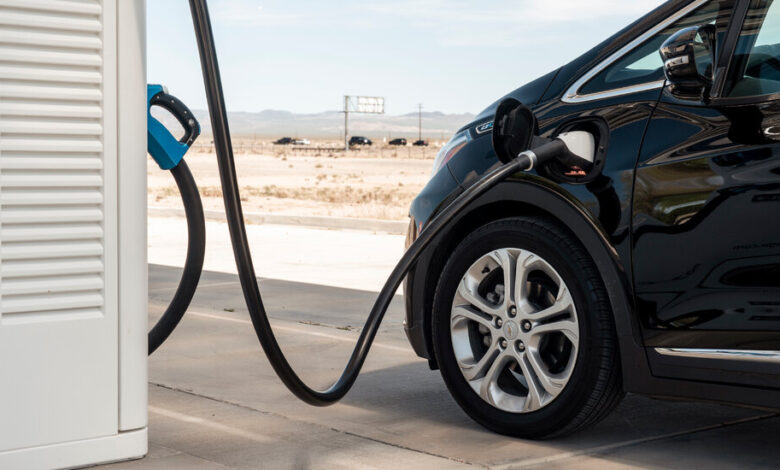Why Buying an Electric Car Just Became More Complicated

WASHINGTON — If you’re a well-paid lawyer eyeing an electric Rivian sport-utility vehicle, you might want to buy it before New Year’s Day. If you’re a middle-class nurse saving up for a compact Chevrolet Bolt, you might want to wait until January.
Those calculations — and a host of others pertaining to the red-hot electric vehicle market — come courtesy of an energy, tax and health care law that President Biden signed on Tuesday. It includes more than $370 billion in spending and tax incentives meant to address climate change, largely by encouraging people, businesses and electric utilities to reduce their use of fossil fuels. One incentive is the extension of a tax credit for the purchase of electric cars and trucks that can be worth up to $7,500.
But that extension is complicated.
The new law, passed with only Democratic votes in the House and Senate, contains lots of new rules that do not all take effect at the same time. Many of those new conditions were added to win over Senator Joe Manchin III of West Virginia, who has expressed reservations about offering subsidies for electric vehicle models that are so popular they have waiting lists stretching out for months.
A central feature of the extension is that it will allow vehicles made by General Motors or Tesla to qualify for the tax credit. Cars made by the two companies had lost access to the credit in recent years because the companies had each already sold more than 200,000 electric vehicles, a quota that the new law does away with, but only starting next year.
Another part of the extension has made other vehicles ineligible for the credit, even if they did qualify a few days ago. That’s because the law immediately restricts the credit to vehicles that are assembled in North America — a limit that rules out several electric cars made by Hyundai, Porsche, Toyota and Kia.
Read More on Electric Vehicles
- Climate Bill: The legislation would offer tax incentives to steer consumers to electric cars. But even with the aid, an uncomfortable truth remains: Battery-powered vehicles are much too expensive for most Americans.
- Plug-In Hybrids: After falling behind all-electric cars, U.S. sales of plug-in hybrids have been surging. The high cost of electric cars and gasoline have given them an opening.
- Can Rivian Deliver?: Amazon ordered 100,000 battery-powered trucks to cut its carbon dioxide emissions, but the fledgling electric vehicle maker will take years to fulfill the order.
- Next-Generation Batteries: Makers of batteries for electric vehicles that could charge in a few minutes are bringing the technology a big step closer to auto showrooms.
Only 21 car and truck models, including three from Rivian and a half dozen from under the Ford umbrella, for 2022 and 2023 are eligible to receive the credit if buyers snag them after Tuesday but before the end of the year. The Energy Department released a list of vehicles that probably still qualify.
It gets tricker from there.
Starting next year, there will be limits on how much a qualifying vehicle can cost, and how much income an individual or household can earn to be eligible for the credit. Eventually, the law phases in requirements for how much of the vehicle’s battery must be made in North America to qualify.
The reason for those restrictions is twofold. First, Democrats in Congress and Mr. Biden do not want to encourage only electric vehicle sales; they also want to push automakers to assemble electric cars and their batteries in the United States, from components that are made domestically or by friendly countries. A central aim is to make the United States less reliant on China, which currently controls much of the supply chain of electric car batteries.
This is what economists call industrial policy: using the power of government to foster the growth of strategically chosen domestic industries. Democrats are betting that automakers will change where they buy materials and make cars and batteries to take advantage of the new credits.
Second, the income limits are an effort to keep relatively high earners from benefiting from the government incentives. Tesla’s fast-growing sales in recent years have demonstrated that buyers of luxury cars are willing to spend tens of thousands of dollars on electric cars that are not eligible for tax credits.
The whole package has left industry analysts — and some prospective car buyers — confused about the details. The Treasury Department began to issue guidance this week on how all those new rules and limits will be implemented. It will be awhile before all the guidelines are set. This is what we know so far:
-
If you bought an electric vehicle between the start of the year and Tuesday, and it previously qualified for the credit, don’t sweat it. You can still claim the credit on your taxes next year.
-
If you ordered a qualifying electric vehicle before Tuesday and it hasn’t yet arrived at the dealer, you can most likely still claim the credit, provided you entered into a “written binding contract.” The Internal Revenue Service has said that could be as simple as having put down a nonrefundable deposit.
-
For any other vehicles purchased after Tuesday, but before the end of this year, the new North American assembly rules apply. That means your choices for a qualifying car or truck have been limited fairly significantly, compared with what they were on Monday. But under Treasury’s guidance, that’s the only new rule that takes effect this year. If your household earns more than $300,000 annually, or you’re eyeing a Rivian pickup truck or S.U.V. with options that push its price above $80,000, you have a few months left to make a purchase that qualifies for the credit.
-
Starting next year, the income limits and the vehicle-price limits kick in. Some vehicles will regain their eligibility for the credit — initially, that means any electric S.U.V., pickup truck or van made by General Motors or Tesla that costs $80,000 or less (provided you’re under the income limit) or any sedan that costs $55,000 or less.
-
No later than 2024, the government will begin applying the requirements for battery content, a portion of which must be sourced from North America. It will also require critical minerals for the electric motor to be sourced from the United States or a country with which it has a free-trade agreement — a list that notably excludes China. The percentage requirements will ramp up over time. That could knock more vehicles out of eligibility. Or, if the Democrats’ bet pays off, it could push automakers to bring more of their supply chain and production to the United States.





